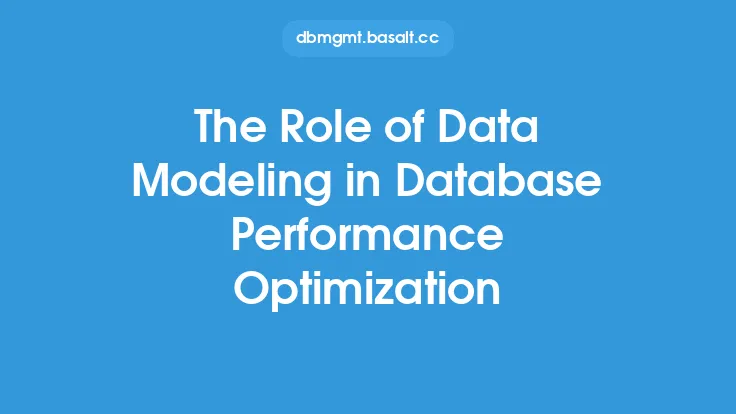Data denormalization is a technique used in database design to improve the performance of queries by reducing the number of joins required to retrieve data. One of the key tools used in data denormalization is the summary table, which is a pre-computed table that stores aggregated data. Summary tables play a crucial role in data denormalization by providing a way to store complex calculations and aggregations in a single table, making it easier to retrieve data and improve query performance.
Introduction to Summary Tables
Summary tables are designed to store aggregated data, such as sums, averages, and counts, which are commonly used in queries. By storing these aggregations in a single table, summary tables can reduce the number of joins required to retrieve data, making queries faster and more efficient. Summary tables can be used to store a wide range of data, from simple aggregations to complex calculations, and can be used in a variety of applications, from data warehousing to real-time analytics.
How Summary Tables Work
Summary tables work by storing pre-computed aggregations of data in a single table. This table is typically updated periodically, such as daily or weekly, to reflect changes in the underlying data. When a query is executed, the database can use the summary table to retrieve the required data, rather than having to calculate the aggregations on the fly. This can significantly improve query performance, especially for complex queries that require multiple joins and aggregations.
Benefits of Summary Tables
The use of summary tables in data denormalization offers several benefits, including improved query performance, reduced storage requirements, and increased data availability. By storing pre-computed aggregations, summary tables can reduce the number of calculations required to retrieve data, making queries faster and more efficient. Additionally, summary tables can reduce storage requirements by storing only the aggregated data, rather than the raw data. This can be especially beneficial in applications where storage space is limited.
Types of Summary Tables
There are several types of summary tables, each designed to store specific types of data. Some common types of summary tables include:
- Rollup tables: These tables store aggregated data at multiple levels of granularity, such as daily, weekly, and monthly.
- Aggregate tables: These tables store pre-computed aggregations, such as sums and averages, for a specific set of data.
- Data mart tables: These tables store a subset of data from a larger database, often used for reporting and analytics.
- Materialized view tables: These tables store the result of a query, often used to improve query performance.
Designing Summary Tables
Designing summary tables requires careful consideration of several factors, including the type of data to be stored, the frequency of updates, and the query patterns. The design of the summary table should be based on the specific requirements of the application, taking into account the types of queries that will be executed and the data that will be retrieved. Additionally, the summary table should be designed to minimize storage requirements and optimize query performance.
Implementing Summary Tables
Implementing summary tables requires a thorough understanding of the underlying data and the query patterns. The implementation should include a process for updating the summary table, such as a daily or weekly update, to reflect changes in the underlying data. Additionally, the implementation should include a mechanism for handling errors and inconsistencies, such as data validation and error logging.
Maintaining Summary Tables
Maintaining summary tables requires regular updates to reflect changes in the underlying data. This can be done using a variety of techniques, such as incremental updates or full table rebuilds. Additionally, the maintenance process should include a mechanism for handling errors and inconsistencies, such as data validation and error logging. Regular maintenance is critical to ensuring the accuracy and reliability of the summary table.
Best Practices for Summary Tables
There are several best practices for designing and implementing summary tables, including:
- Use summary tables to store pre-computed aggregations, rather than calculating them on the fly.
- Design the summary table to minimize storage requirements and optimize query performance.
- Use a regular update process to reflect changes in the underlying data.
- Implement a mechanism for handling errors and inconsistencies, such as data validation and error logging.
- Monitor query performance and adjust the summary table design as needed.
Common Challenges and Limitations
While summary tables can offer significant benefits in terms of query performance and data availability, there are also several common challenges and limitations to consider. These include:
- Data consistency: Ensuring that the summary table is consistent with the underlying data can be a challenge, especially in applications with high transaction volumes.
- Data freshness: Ensuring that the summary table is up-to-date can be a challenge, especially in applications with real-time data.
- Storage requirements: Summary tables can require significant storage space, especially for large datasets.
- Query complexity: Summary tables can be complex to design and implement, especially for complex queries.
Conclusion
Summary tables play a critical role in data denormalization, providing a way to store pre-computed aggregations and improve query performance. By understanding how summary tables work, the benefits they offer, and the challenges and limitations they present, developers and database administrators can design and implement effective summary tables to meet the needs of their applications. Whether used in data warehousing, real-time analytics, or other applications, summary tables are a powerful tool for improving query performance and data availability.





